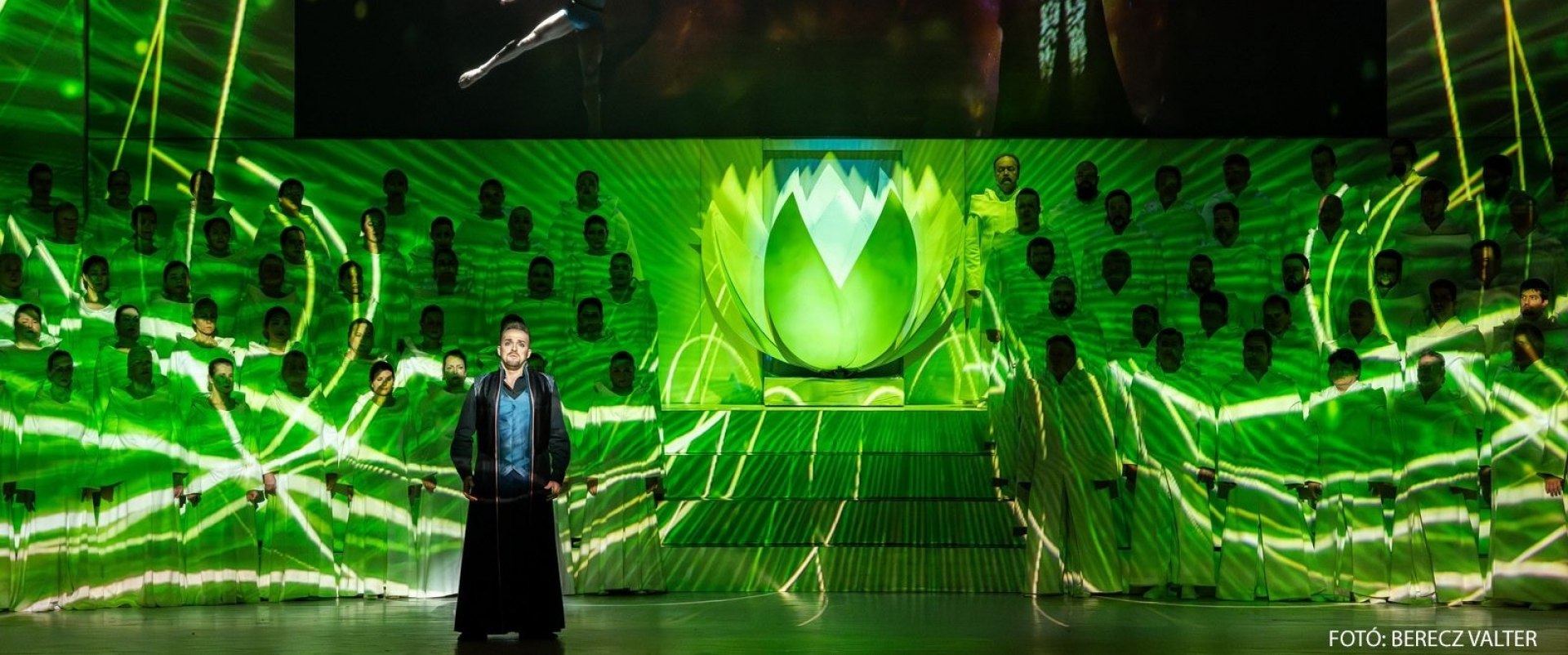Carmina Burana
Mo | Tu | We | Th | Fr | Sa | Su |
CARMINA BURANA – Carl Orff
Scenic cantata in the original languages, with Hungarian, English, and original-language surtitles
Running time: 2 hours 15 minutes, including one interval
O Fortuna. Everyone knows the overwhelmingly powerful opening motifs of Carl Orff's most famous work. What fewer people know is that Carmina Burana was not intended to be an oratorical work, but was instead expressly meant for the stage. This becomes clear from the piece's (originally Latin) subtitle: “Secular songs for singers and chorus to be sung together with instruments and magical images.”
Over the course of the many times he has conducted the work, Tibor Bogányi gradually developed a vision for a staged version. The creators conceived a breathtaking spectacle to surround the three soloists, the three dancers from the Hungarian National Ballet, and the monumental 120-strong chorus singing from memory, as well as the children's chorus, with the 3D “magical images” coming to life on six projection displays and LED walls.
Since all this is happening in an opera house, the hour-long Carmina Burana is preceeded by a 30-minute-long opera showcase, a gift concert of sorts, which in the 2025/2026 season will include the most popular excerpts from Beethoven's, Mozart's, Wagner's œuvre: promising to the OPERA, the hope of Carmina Burana fans returning to opera performances, too.
Age restriction: The performance is not recommended for children under 12 years of age.
Parental guidance: We wish to inform you that we occasionally use light effects that may be disturbing or excessively bright for some members of the audience.
Synopsis
Magical images in 3D
For 15 years, painter and organist Ágnes Zászkaliczky and conductor and cellist Tibor Bogányi have been working together on finding ways to attract a wider range of audience segments to classical concerts by enhancing their productions with singular visual experiences: Zászkaliczky selects projected material from paintings created expressly for the given musical piece. Their largest-scale effort to date is the super-production Carmina Burana, which they put together with the world-renowned Budapest-based Freelusion Studio.
“We worked out the basic concept of Carmina Burana together with librettist Attila Könnyű. Not long after the idea was conceived, we found the Freelusion team, whose unique technical and artistic expertise allowed us to raise the concept of “visual concerts” to a new level. Through this collaboration, we developed real-time three-dimensional visual material that is in perfect harmony with the music. The essence of the concept is the fact that it is not the visuals that dictate the tempo, but rather the music: it is not the conductor’s task to “accompany” an existing film or animation, like at so many concerts of film music, for example. Instead, the music takes centre stage, and everything else adapts to it. We therefore had to create a form of animation that would be suitable for following the music live during the concert.
In the music, Orff followed and expressed the messages of the songs with extraordinary sensitivity. Starting from Orff’s own concept, we have selected “magical images” that reinforce the effect of the music without suppressing it, and which make the text more profound without illustrating it. The dynamic of the moods of the projection is organised along the lines of the major movements. We’ve built upon ancient symbols that can be found both in Hungarian and universal motif systems. Tímea Papp, Freelusion’s superb choreographer, we decided which movements would also incorporate dance to be performed by the outstanding dancers from the Hungarian National Ballet. We hope this will transport the audience to a magical virtual reality through Orff’s elemental music and the unique visual experience.”
Tibor Bogányi and Ágnes Zászkaliczky
Program and cast
Conductor: Dániel Erdélyi, Tibor Boganyi
Soprano - Zsuzsanna Kapi, Orsolya Sáfár, Erika Miklósa
Alto - Andrea Meláth, Gabriella Balga, Mária Farkasréti
Baritone - Csaba Szegedi, Zsolt Haja
Featuring: Adrienn Pap, Tymofiy Bykovets, András Szegő, Diana Kosyreva, Miklós Dávid Kerényi, András Rónai, Kristina Starostina, Iurii Kekalo, Ricardo Vila M.
Featuring the Hungarian State Opera Orchestra, Chorus, and Children's Chorus, as well as the Hungarian National Ballet
Concept: Zászkaliczky Ágnes
Concept: Attila Könnyű
Concept: Tibor Boganyi
Director: Tibor Boganyi
Artistic director: Zászkaliczky Ágnes
Artistic director: Tibor Boganyi
3D projection mapping: Freelusion
Choreographer, visual designer: Tímea Papp
Chief graphic designer: Ádám Herczeg
Costume designer: Szelei Mónika
Chorus director: Gábor Csiki
Head of the children's chorus: Nikolett Hajzer
Hungarian translation by Pödör Ferenc
English translation by Anonymus
Hungarian State Opera
STANDING ROOM TICKETS - INFORMATION IN CASE OF A FULL HOUSE!
If all the seats are sold out for the selected time, but you still want to see the production on that day, 84 of the extremely affordable standing seats will be sold at the theatre, 2 hours before the start of the performance, with which you can visit the gallery on the 3rd floor. Tickets can be purchased at the ticket office of the Budapest Opera House. We would like to draw your attention to the fact that the stage can only be seen to a limited extent from the standing places and the side seats, but at the same time, following the performance is also supported by television broadcasting on the spot.
The Opera House is not only one of the most significant art relic of Budapest, but the symbol of the Hungarian operatic tradition of more than three hundred years as well. The long-awaited moment in Hungarian opera life arrived on September 27, 1884, when, in the presence of Franz Joseph I. the Opera House was opened amid great pomp and ceremony. The event, however, erupted into a small scandal - the curious crowd broke into the entrance hall and overran the security guards in order to catch a glimpse of the splendid Palace on Sugar út. Designed by Mikós Ybl, a major figure of 19th century Hungarian architecture, the construction lived up to the highest expectations. Ornamentation included paintings and sculptures by leading figures of Hungarian art of the time: Károly Lotz, Bertalan Székely, Mór Than and Alajos Stróbl. The great bronze chandelier from Mainz and the stage machinery moda by the Asphaleia company of Vienna were both considered as cutting-edge technology at that time.
Many important artists were guests here including Gustav Mahler, the composer who was director in Budapest from 1887 to 1891. He founded the international prestige of the institution, performing Wagner operas as well as Magcagni’ Cavalleria Rusticana. The Hungarian State Opera has always maintained high professional standards, inviting international stars like Renée Fleming, Cecilia Bartoli, Monserrat Caballé, Placido Domingo, Luciano Pavarotti, José Cura, Thomas Hampson and Juan Diego Flórez to perform on its stage. The Hungarian cast include outstanding and renowed artists like Éva Marton, Ilona Tokody, Andrea Rost, Dénes Gulyás, Attila Fekete and Gábor Bretz.

 EN
EN DE
DE IT
IT FR
FR ES
ES RU
RU JP
JP RO
RO
 Seating plan
Seating plan 